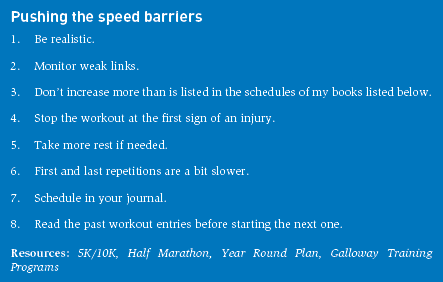

| 82 | To put myself to the test – time goal |
Most citizens of the 21st century never know what it is like to push themselves to their physical limits. Training to finish the half or full marathon stimulates many couch sitters to dig deep for the motivation to meet regular challenges. The addition of a time goal that is challenging regularly requires a search for the willpower to keep going when it’s tough.
When runners dig down for inner strength, they almost always discover it. Embedded in our DNA is the toughness developed by ancient ancestors who faced far greater challenges than finishing or running faster in a half or full marathon. When we push ourselves a bit farther or faster than we’ve gone before, we engage circuits that are hardwired into our being that keep us going.
But there are also circuits that try to protect us from pushing too far. The subconscious brain monitors stress buildup. When the level is determined to be too high, the reflex triggers anxiety hormones that cause one to question whether to keep exerting at that level. As the stress continues to increase, negative attitude peptides are stimulated by this subconscious brain.
Through a series of training components, you can train yourself to deal with stress in several specific areas:
| • | Long runs push back endurance |
| • | Speed training pushes back stress due to running faster for a longer distance |
| • | Form drills get one ready to shift into a smoother running gait when needed |
| • | Mental training allows one the willpower to keep going even when stressed |
Over 4-6 months, you will gradually build up the workload, allowing your body to adapt to increased performance. During a series of workouts, you gradually push beyond what you have been able to do currently. All of the workouts, with backup information, are detailed in Year Round Plan, Half Marathon, 5K/10K, and Galloway Training Programs.
There is always a risk when picking up the speed. By carefully monitoring your weak links, as noted in the book Running Injuries – Care & Prevention, there are few aches/pains/injuries. The greatest risk is that of failing. There are almost always workouts when the runner doesn’t know whether he or she can finish it.
By making adaptations and learning how to keep going, the frontal lobe goes into action. The left side solves problems. The right side looks for sources of internal strength to keep going. They almost always find what you need.
Because you are in the human, conscious brain, you can gain control over the negative hormone production from the subconscious brain. You discover how you can overcome anxiety and doubt and be what you could be . . . on that day.
For more mental techniques and information, see Mental Training for Runners, available at www.jeffgalloway.com

| 83 | Not being afraid to fail |
Just when our ego is running at an all-time high, running experiences bring us back to earth, literally. You can expect for the ego to project continuous progress during a training program – no performance is good enough, you can do better (says the ego).
When we want to run faster, the ego will help us push toward the goal, but it must be managed. When our performances don’t equal the ego’s projection, we are presented with one of the greatest opportunities among all growth experiences: to learn from our mistakes.
All of us are capable of extraordinary accomplishments in running and in life. To achieve a level that is “on the edge” of our experience, we must take on the risk of failure. Some cannot handle this and back off without ever testing themselves. They cut themselves off from finding hidden strengths inside, which are almost always found. The other loss is that from the exhilaration of attempting a significant challenge – even when not achieved.
I don’t know of any successful person who has not failed. It is in the evaluation of a disappointing run that we question everything: goal, training, pacing, strategy, mental toughness. This activates the frontal lobe to start searching. It may not find the answers right away, but it usually does as the weeks and the workouts continue to reveal issues.
The training journey takes us through a series of gentle risks, usually balanced by gentle successes. This allows for continuous adjustments to avoid each setback in the future. One of the most important learning issues is determining how much we want to improve. Failure is often measured as the difference in our projected goal between the ego and our conscious brain in the frontal lobe. When egos tell us that we have not run as fast as we should, evaluate!
Spend 1-3 days figuring out what you could have done better. In most cases, you will have several items. Project ahead to the next workout/race and make the adjustments to improve your performance. Once you have learned from your setback, move on to the next goal.
Doubts do not mean that you don’t have the confidence to achieve a goal. They spring from the stress of a workout plan that gears you to higher performance and the pressure of the goal itself. As the stress level rises, the reflex brain triggers hormones that leave you anxious and doubtful.
Embracing the fact that we may not succeed is a breakthrough. At this point, success is often produced by not giving up and continuing to run even when you doubt that you can keep going. We have many circuits in our brains that connect us with resources to keep going when we don’t know what is going to happen. The more often we use them, the better we adapt our mind-body organism to realizing its potential on a given day.
It is the fear of failure that is more likely to keep us from our goal, not the act of failure. Such fears trigger negative hormones reducing motivation and reducing capacity of certain key circuits in the brain.
Taking action produces positive hormones. Set up a plan of training and action. This will get you into the frontal lobe instead of the subconscious reflex brain that responds to stress. As you fine-tune the plan and believe in it, you continue the flow of positive hormones.
The magic mile (MM) is crucial to the strategy. This will predict your current potential. It is OK to project a 3%-5% improvement during a season of training. Use the cognitive training methods in my book Mental Training for Runners to prepare you for the effort.
The MM gives you a glimpse into the future. If you don’t achieve your goal on the first try, you can learn from your mistakes and go for it again.
Making adaptations as you go helps you become a smarter, faster and better runner – if you’re not afraid to fail.
| 84 | To deal with challenges |
There is something exhilarating in overcoming a challenge and going on to finish a race or workout. Once you do this a few times, you’ll develop the confidence to confront future issues. You’re also setting up a circuit that can be used to deal with challenges in other areas of life. It may surprise you, but the best way to get through a challenge may not be pushing harder.
Make sure your goal is realistic. Use the MM time trial (page 139). This will help you avoid the frustration of running at a race pace that you are currently not ready to run.
Don’t give up. The single reason why some runners succeed and others don’t is that the winners don’t give up, nor do they neglect training because of setbacks. Learn from mistakes and keep trying.

Save resources! When a physical challenge occurs during the early or middle portions of a hard effort, it’s a sign that some of your resources are not ready for the challenge at that moment. Ease off the effort for a minute or so and then gradually ease back to the point that feels do-able during that workout or race.
During workouts, you can push the middle section of each fast segment. When you’re running a one mile repeat, to improve your marathon speed, run the first quarter mile and the last quarter mile at goal pace and the middle portion about 30-45 seconds per mile faster than goal pace.
Save your best effort for the end of the race. Many studies and surveys show that by conserving resources early in a distance race, one can run faster times overall. Having a strategy allows you to use the conscious brain, be “in the moment,” and make the changes you need to overcome the challenge of the moment while staying on track for your goal.
As you manage your challenges, with the strategies that worked, you’ll learn more with each experience.
| • | When to keep going at a given effort level and when to back off. |
| • | When to continue trying and when to save the effort for another day. |
| • | When to have a good time, and when to go for a fast time. |
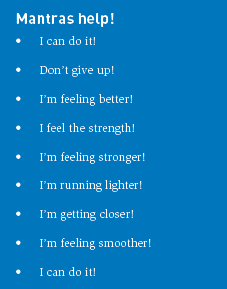

| 85 | Finishing a tough workout |
You’re into a hard workout, and you’re really tired. The stress is building up in the subconscious reflex brain, triggering anxiety hormones. This is a warning sign that things could get worse, but you don’t focus on the negative feelings that will stimulate negative attitude peptides.
Instead, you put yourself into neutral. You’re not continuing to push harder, you simply keep going. It’s OK to let the times of the speed repetitions slip a bit. At the same time, evaluate whether there is a real medical reason why you can’t run the workout assigned. If there is a reason, back off and call it a day. This will get you under the control of the conscious brain and allow you a chance to recover and come back to this workout within 2-3 days.
The problem is most commonly due to not taking conscious control over your thinking during a tough workout. You are letting the reflex brain build up stress and then subconsciously trigger negative attitude hormones. To do your best in a race, you must learn how to deal with these problems in workouts. As you push through these motivational slumps, you will develop the internal resources to do so when you have even more challenges later. You will also change the chemistry inside billions of cells, sometimes within a minute or two.
By using the cognitive strategy below, you can take control over the reflex brain and significantly reduce the production of negative peptides. If you are realistic about your effort on that day and go through a positive thought process, you can stimulate the production of positive attitude hormones.
Each of us has a lot more control over our situation in a stressful workout than we think we do. By practicing the strategy below and believing in the results, you can not only finish the workout you need to prepare for your next goal, but you can access the conscious brain to retrain the reflex brain to move you into a positive mindset – even when tired and under stress.
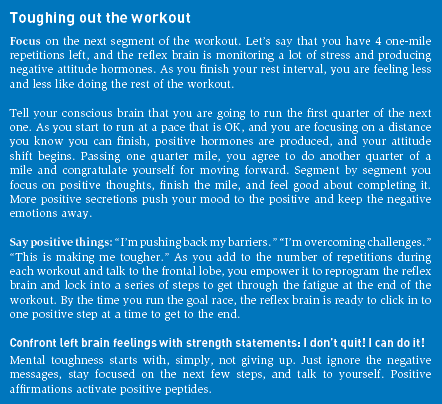
| 86 | When you start to “lose it” in a tough race |
Champions feel the same or greater discomfort as the ones behind themselves; they just hang on longer and get through it. You have it in you to play a poker game with yourself and the others behind you. Even if you feel stressed, tired and not up to the task, break up the remaining distance into segments. Focus only on the next segment.
It’s possible to reverse a downward drift in motivation when under the physical and mental stress of a race. The greatest reward is an amazing sense of satisfaction from turning a negative situation into a positive one. Due to the increasing physical fatigue and pressure that you put on yourself, there will be feelings of doubt and low motivation triggered by the subconscious reflex brain. If you focus on these messages, you will produce negative attitude peptides.
| • | By rehearsing the negative messages you could get, you will desensitize yourself to their attitude-lowering effect. |
| • | Confront each negative feeling with a positive statement: |
The negative is . . . the positive is . . .
“Back off, this isn’t your day.” “Don’t give up!”
“There are other races.” “I can do it today!”
“Why are you doing this?” “I’m getting tougher!”
| • | Evaluate whether there is a real medical reason (which is rare). If there is a health problem, back off and conserve — there will be another day. |
Most commonly, the reflex brain is responding to the stress buildup of the race by triggering negative peptides, creating a negative emotional environment. A successful strategy during the first onset of this attitude downturn is to glide a little. If needed, take a short walk break (15-20 seconds) to mentally regroup and focus on the next segment of the race.
| • | Activate your rhythmic breathing (mentioned in the in the “Jumpstart your motivation” section, page 45. Smile and start running again with a light touch and smooth cadence. Each one of these actions engages the frontal lobe and stimulates the positive peptides to transmit a message of hope throughout the body. |
| • | To do your best in a race, you must manage the stress buildup by using a routine such as those that follow. You are training yourself to keep going, which is 90% of the battle. You are also programming the conscious brain to regularly check on the reflex brain, stop the negative thoughts, and insert positive beliefs. |
Note: None of these drills is cast in stone. Adapt them to your needs and strengths. You will continue to edit them as you move through the process.
| • | Confront reflex brain feelings with strength statements: Don’t quit! I can do it! In your speed workouts, practice the following drill. Fine-tune this so that when you run your goal race, you will have a strategy for staying mentally focused and positive. Your belief in a plan will increase the production of positive motivational hormones. |
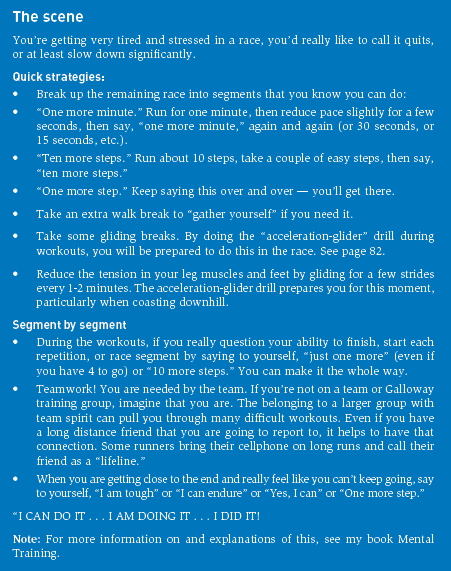
| 87 | I have a secret weapon: I know my current potential |
Most runners go into a race without knowing how fast they are ready to run. It’s not surprising that most let their egos set a pace that is too fast. The result is a dramatic slowdown during the last portion of the race.
Knowing your current potential gives you a huge advantage. This will not only motivate you to do your best, it will bestow confidence. When you believe in what you can do, you are more likely to achieve at that level.
In our Galloway training programs, we use the “magic mile,” or MM, which has been an extremely accurate predictive tool. It is based upon tens of thousands of reports and is described in the sidebar below.

Whether you choose the MM or another predictor, use it regularly. This allows you to set realistic goals and keeps you from exceeding your speed limit on long runs, during time goal workouts, and at the beginning of races.
The MM tracks how much one slows down when running longer events and can designate a safe pace per mile on long runs. It is inserted into a few key workouts each month as noted in the schedules in my books 5K/10K, Half Marathon, Galloway Training Programs, and Year Round Plan. Just look at the weeks that have the MM listed.
Using the MM activates the frontal lobe, or the executive brain. In doing so, you gain conscious control over your training and stay focused. This “human brain” can override the subconscious reflex brain when it gets over-stressed and help to reduce negative attitude hormones. Conscious evaluation of the MM can hold back the ego projections, which are almost always too optimistic.
Look at the information below to see what your MM time predicts in your goal race. If the MM predicts a current time goal, runners are motivated to pursue this goal. You know that it is possible and that activates positive attitude hormones.
If the MM predicts a slower time than your time goal, this is a signal to “step up” the training. You will have several chances to improve, and most runners keep getting faster throughout the program. Since the MM predicts the best possible performance under ideal conditions, it’s best to record an MM time that is faster than you need.
At the end of the season, take your best MM time and do the math. Add 10-30 seconds per mile to adjust for “imperfect” conditions on race day. You’ll then have a realistic goal and the confidence that will help you achieve it.

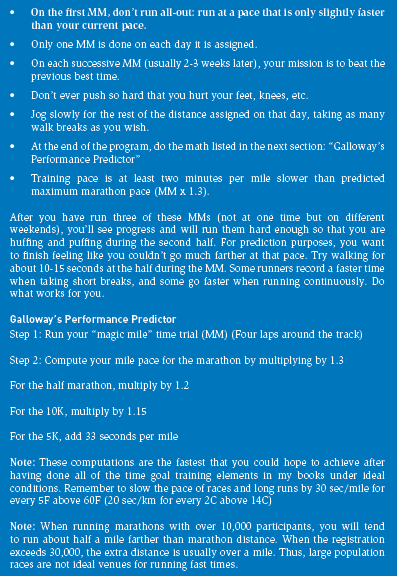
| 88 | To prepare for my goal |
Because I have an appointment with a race on my calendar, I feel more motivated to get out and run. I choose the goal and date, so I’m in charge.
Some find a challenge in a 5K/10K. But many can bluff their way through these distances and need a half or full marathon to challenge them to do all of the training runs. The goal must be demanding enough so that the individual knows that he/she must check each workout off the schedule.
Avoid putting stress on yourself. Use the MM in the segment above this one. The magic mile is a reality check on your goal and can help you monitor progress on the way to your goal race.
After several campaigns, there is satisfaction in knowing that you are making progress – that each workout has a purpose. You are getting the job done by getting out there.
Barbara and I are currently running a marathon every month. Even after having finished over 160 marathons, I’ve not found any of them to be easy or routine. Our scheduled marathon each month is our goal/challenge and also serves as the last long run for the next one.
Many of my e-coaching clients find that a race of any distance, once a month, “keeps them honest” in terms of getting in the runs during the week. Not only do you want to be prepared, but the finishing of any event tends to bestow motivation for weeks afterward.
Just crossing the finish of a significant event is empowering and can change the way you look at yourself for the better. Even more powerful is the continued reinforcement of 6 months of success stories. Each training success leads you toward the race. Each finish gives a boost to the next training season.
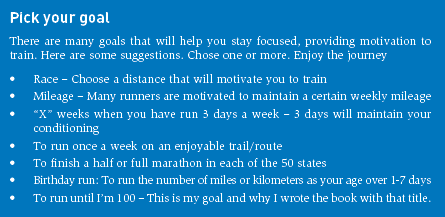
| 89 | To set my own personal record |
There’s a significant uplift to the spirit when we run a personal best. Most runners can accomplish this every year by using a little creativity.
Among my e-coach clients who have done the work necessary to improve, most have continued for at least 10 years from the time they started running. The prime reason for success tends to be focusing on the key factors that provide the maximum improvement, such as increasing the long run and targeted speed sessions.
Staying injury-free is another crucial element. I’ve sustained an injury-free streak of over 30 years by following the tips in Running Injuries – Care/Prevention. I have heard from many other runners who have avoided injuries for decades by following the principles in this book.
Mature runners who have reached a peak and/or don’t want to do speedwork can pick a distance that they have not run before. Have fun with this. For example, if your birthday is January 11, measure an 11-mile course or an 11km course and run it for time. You may set a world record for some distances. Some push back their endurance record by running one mile (or one kilometer) farther on their birthday week each year.
It helps to challenge a friend when running these distance or time records. Set up a goal date for setting the record and enjoy some “trash talk” as you go through the training.
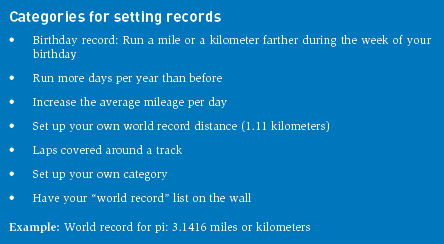

| 90 | To break through previous distance barriers |
One of the greatest feelings of empowerment in life comes from going farther than you have run in the last month or so. Pushing back the endurance barrier signals your mind-body that you are improving and you’re getting better.
If you run slowly and insert frequent walk breaks, there are many physiological enhancements that occur during a series of gradually increasing long runs.
| • | Heart function increases |
| • | Blood circulation is improved |
| • | Capillaries increase in the exercising muscles |
| • | Fat burning capacity is enhanced |
| • | Running form tends to be more efficient |
| • | Mental toughness increases as you keep pushing past the recent longest run |
| • | Stamina to endure other fatigue experiences is improved |
Embedded in the human DNA is the ability to adapt to going farther because this allowed our ancient ancestors to survive. For most of our existence as human beings, food was scarce and covering 10-20 miles a day increased the potential for accumulating the needed calories.
Extending our current distance frontier revs up our performance and triggers circuits that make adaptations in the various body parts and organs. The feet move more efficiently, reducing effort and aggravation. Oxygen absorption increases. The energy system goes into conservation mode. The central nervous system steps up when you go farther, activating body and mind to get the job done.
Some of the most powerful positive attitude hormones are produced when we’re tired and continue to move forward. These “attitude boosters” lock into billions of receptors throughout the mind-body network delivering positive and confident feelings.
Running slower on long runs does not detract from the endurance, accomplishment, or sense of empowerment. Walking more frequently reduces the fatigue without taking away the satisfaction in achievement.
Because you’re solving problems along the way, brain control tends to shift into the frontal lobe. This control center overrides the subconscious brain, managing stress and lowering the production of negative attitude or anxiety hormones.
Frontal lobe thinking keeps you in the moment. You’re open to what is coming next, ready to adapt. The left side deals with logical issues and problem solving. The right side offers creative solutions and intuitive connections to hidden sources of strength.
Slow down and enjoy the exhilaration of going farther.

| 91 | I want to feel the wind on my face |
There’s something exhilarating about being able to pick up the pace and feel like you’re running fast. Your mind-body organism increases capacity, expands awareness, and activates many components that aren’t normally “on alert.”
Actual speed doesn’t matter. What used to be my slowest pace, when I was on the Olympic team, is now my fastest pace. By picking up the speed during a run, even for a short segment, I feel more alive throughout my body. The term I use for these faster segments is “accelerations.”
The distance of this acceleration does not have to be more than 10 to 20 steps. At first, it should be only 10 steps to warm up the legs, followed by easing back to a jog for 20-30 steps. I follow the “Caution – Speed Zone” suggestions below and have not been injured in over 30 years. The gentle warm-up is crucial to acquiring a faster speed.
I enjoy the challenge of working through the various paces as I speed up. I feel the body respond to exertion with more energy and more vitality with mental alertness. Even a few small segments of increase will leave me feeling better after the run.
The actual amount of time run at the fast pace is not very long most of the time. I will usually pick up the pace, ease off, jog, and then repeat the cycle. The “acceleration-glider” drill is my most common format. See the segment on page 82.
Once I’ve achieved my current fast speed, it is exhilarating to feel the wind on my face, to know that I can still pick it up and use my feet and legs to go faster. I don’t run nearly as fast as I did 40 years ago, but I feel as good as ever when I run fast. You can, too!

| 92 | To push my limits |
Some of my real “breakthrough” moments in life, when I really got to know myself, occurred during workouts when I doubted my ability to finish. There’s something about the combination of stresses during an endurance challenge that can tap into a powerful combination of previously unused inner reserves.
Life stress and the demands of exertion can trigger the secretion of negative attitude hormones, reducing blood flow to key areas by the subconscious brain. As we push on during difficult workouts, negative attitude hormones are also subconsciously secreted, reducing motivation. Most average citizens back off or stop the workout and never know what they are capable of doing.
By taking positive mental action, we gain control over our attitude, lower the stress, reduce production of the negative hormones, and can stimulate the production of positive hormones. The simple way to do this is to have a cognitive strategy, such as the one suggested below. This allows you to make changes at any point during the workout. When focusing on logical strategy, brain control shifts to the frontal lobe, which can override the stress reactions of the subconscious reflex brain.
The human organism is designed to rebuild stronger after a significant stress. The best plan for pushing the limits is to schedule a series of workouts, with sufficient recovery afterward, that gradually increase the number of segments of faster-paced running. With each gentle increase, one receives a sense of accomplishment. The repair period afterward does not mean that you have to lie down. Appropriate cross training is allowed. The reduction in intensity will vary among individuals, but usually two or three easy days per week are needed for repair and rebuilding.
Training ourselves to go a little farther when under duress develops the awareness and capability to push on when you don’t feel good. The personal empowerment in breaking through past barriers keeps on giving. I’ve heard from thousands who applied this mental enhancement process to other areas in life: career, family, personal, etc.
Embedded in our DNA is the intuitive ability to activate embedded circuits that keep us going when under stress. During these challenges, we discover that there’s a lot more in our inner resource tank than we thought.
That’s empowering in itself.

| 93 | I love pushing back the speed barriers |
Increasing the number of repetitions during a speed training program bestows a unique sense of achievement. You are not only pushing back the distance, but with each workout you monitor pacing, form, and weak links – making constant adjustments.
The greatest stress, and the source of the greatest improvement, is incurred as one continues to keep going when tired at the end of these workouts. Internal improvements are constantly made in physiology, form, and mental tenacity.
In practically every speed workout, one will reach a point when finishing doesn’t seem possible. Each person must discover her own way of getting through these rough patches. The common factors to get to the finish are first, “don’t give up.” The second step is to simply put one foot in front of another and keep moving.
I’ve had hundreds of speed workouts when I didn’t feel good at any time during the workout. Some of these were superb workouts. The exhilaration in finishing is immense. On those days, you just have to get out there and do it. You learn that the way you feel, body and mind, doesn’t often indicate how you can perform on that day.
Because one must overcome a number of challenges, finishing a speed workout can bestow several layers of satisfaction at once.
